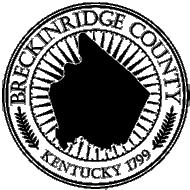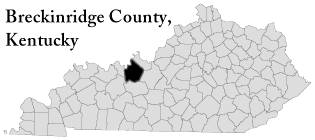 |
USGenWeb Archives Project Breckinridge County, Kentucky |
 |
 |
 |
 |
 |
USGenWeb Archives Project Breckinridge County, Kentucky |
 |
 |
 |
 |
THESE
ARCHIVES BUILT BY YOUR
CONTRIBUTIONS.
PLEASE CONTRIBUTE TODAY!
New
Easy to use Submission
Forms!
This Page Updated Monday, 11-Apr-2022 20:27:47 EDT
| BRECKINRIDGE COUNTY, KENTUCKY |
| AREA COMMUNTIES OF THE PAST AND PRESENT |
| HARNED |
Harned lies in the geographic center of our county. It is
four miles east of Hardinsburg on Highway U. S. 60.
Around
Harned lies some of the best farm land in Breckinridge County and
Harned has produced some of our county’s most progressive
citizens.
The earliest land owner to live in this vicinity was
Nicholas
Scott. Mr. Scott
was born in Virginia in 1789, and came to
Breckinridge County in 1800. He
was married to Miss Mary
Pate. Their log
home is still standing east of Harned on
Forest Davis’ farm
and the land has never been out of the family.
Mr. Scott
had eight children. Some
of his descendants still live in
the community.
He died in 1846
and is buried in the family cemetery.
In the early years of our county, Mr. Hopkins Otey Wales,
settled
the area between Harned and Garfield, which at the time, and
until
the Civil War, was known as the Prince of Wales.
Mr. Wales
owned about 2,000 acres of land on both sides of U. S. Highway 60
and was
centered about where “Dead Man’s Curve”
is now.
As early as 1816, Mr. Wale operated a stage coach station
there
and it was still in operation at the time of the Civil War.
Mr. Wales, who was
the fourth generation grandfather of
Louise Moorman Hook, brought with him to this section, several
slaves.
These slaves of
Mr. Wales’ were of superior quality.
In 1816, when Mr. Thomas Lincoln and his family were on
their
trek from Hodginsville to Indiana, night overtook them at
the Prince of Wales. Mr.
Lincoln, at the time, was almost
destitute.
The spent the night at the Inn for which Mr. Lincoln paid
his way
by splitting wood. At
this time Little Abe was only
7 years old. There
was not room for him at the supper
table, so he was sent to the kitchen to eat with the slaves, but
not so, the slaves
would not sit with that “poor white trash,” so Abe
was
obliged to sit in a corner alone.
Mr. Tom Lincoln spent another night in this Inn when he
came back
to Kentucky to get his second wife, Mrs. Sarah Bush Johnson,
who had been reared in the Fort at Hardinsburg and later married
and moved to Hardin County.
Another early member of this community was Mose Payne, son
of
John Payne, who came from England and settled in Virginia. Mose
Payne came to Breckinridge County in 1834, and settled in the
Locust Hill community. He
married Miss Judith Beard and had
ten children. Miss
Virginia Payne, daughter of Lum Payne
and Elizabeth Scott, was born in Harned in 1886.
She is
still alive and
alert and is related to most of the citizens in Harned today.
Henry Harned came from Virginia and settled in the Custer
community but moved to Harned a few years after the Civil War.
It was he who gave
the right of way and ground for the
depot when the railroad came through the community in 1890, at it
was for him that
the town was named. In
1908, he and most of his family
moved to Oklahoma.
Among the early families in this community, in addition to
those
already mentioned, are the Macys, Weatherfords, Moormans,
Davises, McCoys, Wales, Gruns, Blacks, Tabors, Bruington, and
Driskells.
The railroad track ran north of, but paralleled to U. S.
60
Highway. The old
depot still stands on a back street next
to the
Ephesus road. The
spur, or side track, ran on the south
side of the main line and reached from the present Coleman Payne
property to the
east to where Stanley Blair now lives on the west; a distance of
about a half mile.
Harned, like Glen Dean, did not exist prior to 1890, as a
town.
But with the railroad through the community and its
location
at the base of the ridge, running between the two watersheds,
North Fork and Tuels Creek, it was soon to become a thriving
town.
A profitable lumber business soon was in progress, with
the Dean
Tie Company of Glen Dean, buying most of the ties and lumber.
As late as 1880, the land from Harned to Garfield was
mostly all
in big timber. This
might be better understood by the story
of Mr. W. T. Macy, who lived in Harned and was walking to
Garfield to visit his father. He
got lost in the forest and
found his way home about dark. The
majority of this timber
found its way to market in the early nineteen hundreds by way of
the railroad, whether hewn into cross ties or sawed into
building material for houses and barns.
It isn’t
possible to over accentuate the value of the railroad through
Breckinridge County at this early
date. There were no
roads, trucks or automobiles. The
people who loved away from the rivers, where water transportation
was
available, were virtually marooned.
Prior to the eighteen
nineties, all farm commodities were hauled either to Cloverport
or Stephensport over
narrow, rough dirt roads whether by ox cart or wagon and mules.
Either way was slow and painful.
In the late eighteen
hundreds and
early nineteen hundreds, with a modern and constant means of
reaching market, all the forest on level terrain gave way to
cleared fields and a modern
farming community was in the making.
With more produce of every type being produced, business
places
began springing up in Harned. Old
German Town, which stood
on the road toward Locust Hill, disappeared completely, and
Locust Hill itself, has barely managed to maintain its 1890
population.
About 1880, a school house was built near Ephesus on the
Davis
property. This was
a one-room frame building with homemade
furnishings. Along
each side of the house under the windows
was a long bench where children could sit and do their writing,
and the traditional
recitation bench sat in the front of the room; whereupon, classes
were held.
In 1903, this Davis School was discontinued and the
families
north of Ephesus went to the Shellman School, a little farther
north of the
Ephesus Church and the rest came to Harned to a new school
erected upon the land near the old depot where Mallow Robinson
now lives. This
building lasted only two or three years until a new two-room
school was built in 1906, where Silas Eskridge now lives, just
north of the old railroad at
the intersection of Highway 259 and U. S. 60.
Andrew Driskell, who later became County School
Superintendent,
and his wife were the first teachers in this new school.
A normal school was held here during the summer months for
higher
learning and teacher training.
In 1922, the community had outgrown this two-room building
and a
new three-room school was built where the new Methodist
Church now stands. This
was the pride of the town and
served the needs well until that school was consolidated with
Hardinsburg in 1940.
Mrs. Forest Davis
was the last teacher.
The first settlers of the community held their worship
services
in the homes of the different families, but the first church
building was the
Lost Run Baptist, located east of Harned about one mile, on the
road to Locust Hill. This
church was moved to Harned in
1894, and a new
building erected on the Payne property.
This was on the
southwest corner of Payne Street and Kingswood Road, just
opposite the new Methodist
Church. This
Baptist Church continued to serve the
community until 1930. At
this time, the automobile afforded
easy transportation, and the
congregation was small, so the church was disbanded and joined
the Hardinsburg congregation.
In 1898, the Negro population decided to build a place of
worship. Henry
Harned offered to give them a site upon
which to build,
but they wanted the church located close to the depot so people
from neighboring towns could visit, and get off the train close
to the church, so they bought
land from Green Payne for $20, and built their church, close to
the depot. The
German Town Negro Church was torn down and
re-erected at the
new site. This
church still stands today but because they
could no longer support a pastor it was sold in 1963.
The Ephesus Church was built in 1888 after services having
been
held in the old Davis School for many years.
Rev. L. M.
Woosley,
of Grayson County, preached the dedication sermon. The
Rev.
St. Clair was the first pastor. The
congregation consisted
of the union
Presbyterians and Methodists. This
union was a happy and
successful arrangement, but in 1912, there was need for a larger
Methodist
church in Harned. The
Presbyterians bought the Ephesus
Church and the Methodists built a new place of worship on the
southwest corner of
U. S. 60 and Ky. 259. This
church was used for forty years.
In 1954, a new and beautiful Bedford stone church, one of
which
any
community could be proud, was built on Highway 259, 200 yards
south of U. S. 60.
With the railroad station in Harned, it became the trading
center
for the communities of Ephesus, Lost Run, German Town, Locust
Hill,
Marks Ridge, Buras and the surround county.
George
Nottingham, Mitch Myers and Eli Pile (whose name spells the same
both ways) were early
merchants and made money “coming and going”.
Archibald Weatherford and his son Bob, operated a large
general
store in 1898. A
short time later Mr. Bob Weatherford
bought
his father out and continued to operate the store for twenty-five
years. In addition
to the generally store, he was a
licensed undertaker and kept
on hand, a large supply of caskets.
His elaborately
designed hearse, which was drawn by a beautiful pair of black
Percheron mares, provided
such transportation on one’s final journey, as to take some
of the sting out of death.
The Post Office was in his store for a number of years,
and at
Christmastime his entire store looked like Santa Claus Land.
Mr. Steve Davis ran a produce house in Harned from 1908 to
1940.
This was one of the most thriving businesses in the town. He
bought from farmers, anything they might have to sell.
The
bulk of his business consisted of chickens, eggs, turkeys, geese,
feathers, cream,
butter, cheese, opossum, raccoon, skink, and fox hides, ginseng
and mayapple roots.
In the spring of the year, when the old hens were the most
cooperative, it was not uncommon for Mr. Davis to ship a box car
full of
eggs to New York at one time. In
later years much of his
produce was sent to Louisville by truck.
During the period, from 1900 to, and including the early
thirties, the farmers lived a completely different life from that
which we
know today. Every
boy had a dozen steel traps and knew how
to set snares and deadfalls. If
he had any money to spend
he made it himself,
and there was a time in the early thirties when a good, prime,
black, skink hide would bring more than an acre of tobacco.
Every farmer had a flock
of chickens, two or three milk cows and a man-sized garden.
When chickens got frying size, which is about half grown,
you
could run one down
and wring his neck, where he had been fattened on corn and gotten
his mineral supplement from grasshoppers and katydids and he was
fitten’ to eat.
Modern preachers
just don’t know what good fried
chicken in.
Another big industry which sprang up in the Harned
community was
Capons.
Mr. Dick Green, the County Agent, taught the farmers how
to
caponize chickens. This
made them grow abnormally large and
were
very tender and more tasty, causing them to bring much more on
the market. This
was done by removing the male
speciman’s reproductive organs.
When this was done he,
or it, would lose its comb and high tail feathers, fatten readily
and on occasions would cluck and hover over baby chickens
like an old hen.
Joseph Duggins was a combination merchant and preacher. He
was pastor of the Harned Baptist Church in the early nineteen
hundreds, but kept a stock of grocies in his home to sell. This
was the only place groceries could be bought on Sunday
afternoons.
Jonas Gray also ran a store in Harned the first decade of
the
nineteen hundreds, but sold out to Mr. G. P. Macy.
Mr. Macy
ran
a general store but kept on hand, a lot of hardware and sporting
goods.
Mr. Ben Ed Gray operated a blacksmith shop in Harned for
many
years and, like most village blacksmiths, could repair about
anything
a farmer could break. There
is little doubt that the
ingenuity of the countless number of village blacksmiths in
America led to the resourcefulness
and inventive ability of the American people, making this the
greatest nation on the earth.
In 1914, the last remaining need of the community was net
when
Dr. Joseph Matthew built his office in Harned.
He served
his
people well from 1914, until his death in 1946.
No human
being ever endured more hardships in order to alleviate human
suffering than did Dr. Joe.
No night was too
dark, cold or rainy, to keep him from
riding horse-back to visit a sick patient.
His death was
untimely, due to exposure
and thirty-two years of constant strain.
His office was a
one story, plain building from 1914 to 1946, at which date he
moved his office “Upstairs”.
In 1891, with the coming of the railroad, it was no longer
necessary to travel to Hardinsburg to get the mail.
It was
brought into
Harned on the train and a new post office was built.
Mr. Ed
McGuffin was the first postmaster.
In 1918, while Wilbur Pile was postmaster, the first rural
route
was established from Harned to serve the people north of town.
Contract service to the south had been in effect since
1891.
The distance of these mail routes was established by tying
a rag
to a buggy wheel and
county the times it turned over.
Cleve Black was the first rural carrier.
In 1922, Mallow
Robinson took over the Northern Rural Route and served those
people for
forty years until he retired in 1962.
Miss Jenny Payne took over the post office in 1927, and
served
until 1945. At his
date Mrs. Jane Miller, a niece of Mr.
Eddie Dittle
of Western Kentucky State University, was appointed postmaster,
and has served the community well for these twenty-one years.
In 1927, Mr. Bob Weatherford sold his general store to Mr.
Lee
Alexander, who also took over the undertaking business.
His
son,
J. L. Alexander, is in the same business in Irvington now.
Mr. Fred Layman in 1950, became Grand Master of the
Kentucky
Masonic Lodge. He
is a member of Breckinridge
Lodge No. 67.
In 1965, the first classes met in the new million dollar
consolidated high school, built at Harned, which was the exact
geographic
center of Breckinridge County. This
new building is
ultramodern in design. Much
credit can be given to the
county school superintendent,
O. J. Allen, and our County School Board.
This was a
tremendous and tedious undertaking which required sacrifice and
patience. A
bond issue was passed overwhelmingly, which indicated the
progressive quality of our Breckinridge County people.
Our school is staffed with one of the best faculties in
the
state.
Harned is a small town, only seventy-five years old, but
is
growing fast and populated with the best people on earth. Anyone
who tastes their water and friendship will never want to live
elsewhere.